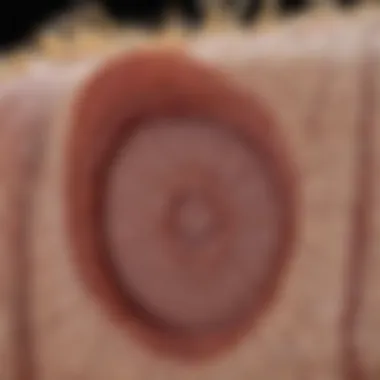Effective Strategies for THC Removal from Hair


Intro
The presence of tetrahydrocannabinol (THC) in hair follicles can present significant challenges, especially in environments sensitive to drug testing, like workplaces and educational institutions. Understanding how THC is retained in hair, as well as the methods to remove it, is crucial for individuals who may face scrutiny over their cannabis use. This article will cover a range of effective strategies to cleanse hair follicles of THC, delving into the underlying chemical processes, evaluating various products, and discussing the practical implications of hair follicle drug testing.
Research Highlights
Overview of Key Findings
Research indicates that THC can bind to the hair shaft through various biological and chemical mechanisms. Studies suggest that the lipid soluble nature of THC allows it to be incorporated into hair as it grows, making detection possible for an extended period. Products designed to cleanse hair of THC seek to disrupt these connections, enabling removal before testing occurs.
Significance of the Research
Understanding the retention and removal of THC from hair follicles has significant implications for many sectors. As more states legalize cannabis, the relevance of accurate drug testing becomes increasingly important. This research can aid individuals in making informed decisions and developing effective strategies for managing their THC presence.
Methods for THC Removal
Various methods exist to address THC retention in hair follicles. These techniques range from home remedies to commercial cleaning products. Below is a breakdown of several approaches:
- Detox Shampoo: Products like Old Style Aloe Toxin Rid and Zydot Ultra Clean are designed specifically to eliminate drug toxins from hair. Users are advised to follow all instructions accurately to increase efficacy.
- Home Remedies: Some individuals attempt to use natural ingredients like vinegar, baking soda, and lemon juice. While anecdotes suggest some effectiveness, scientific backing is limited.
- Bleaching: This method involves the application of hair bleach to reduce THC levels. However, it can severely damage hair, making it a less favorable option.
- Zinc-based Shampoos: Some formulations include zinc, which may help in removing drug residue due to its binding properties.
- Frequent Washing: The most straightforward technique is regular washing. However, frequent shampooing alone may not be enough to eliminate THC effectively.
"Regular washing and detox shampoos may not be sufficient alone; a combination of methods may yield better results."
Implications in Professional and Personal Contexts
The need for clarity around THC presence in hair has implications beyond personal health. In professional settings, employees may face significant penalties including job loss, depending on the results of drug screenings. In personal contexts, individuals may need to display responsibility regarding substance use, particularly in fields with strict adherence to drug policies.
The End
The exploration of THC removal methods is vital in an increasingly complex landscape of cannabis legality and drug testing. Individuals should stay informed on the most reliable methods and products available to navigate these challenges effectively.
Understanding THC Retention in Hair
Understanding the retention of tetrahydrocannabinol (THC) within hair follicles is essential for appreciating the challenges individuals face regarding drug testing. THC is the main psychoactive compound found in cannabis, and its detection in hair is persistent, raising concerns in several contexts, including employment and legal matters. This section will explore various dimensions of THC retention, establishing a thorough foundation for the considerations in subsequent sections.
The benefits of understanding THC retention include better preparation for hair follicle drug tests and informed decision-making when choosing cleansing methods. It is relevant to grasp the mechanisms behind how THC binds to hair, which will guide readers in navigating their options. Moreover, knowing the factors influencing these processes may help manage expectations when utilizing different detoxification methods.
The Pharmacokinetics of THC
Pharmacokinetics refers to how a substance is absorbed, distributed, metabolized, and excreted in the body. In the case of THC, once administered, it travels through the bloodstream and can ultimately deposit into various tissues, including hair.
After using marijuana, the body metabolizes THC into various compounds known as metabolites. The primary metabolite, 11-nor-9-carboxy-THC, has been linked to drug testing. THC and its metabolites can persist in hair for weeks or months, depending on several factors, including the frequency and method of use. This highlights the complexity of THC retention and its significance when evaluating cleaning methods.
Hair Structure and Drug Incorporation
Hair is primarily composed of keratin, a structural protein that forms the bulk of the hair shaft. The incorporation of THC into hair is a process influenced by both the biochemical properties of the drug and the structure of the hair itself.
As THC circulates in the bloodstream, it enters the hair follicle through a process called transepidermal elimination. This means that compounds in blood can penetrate the hair structure as it grows, thereby embedding THC into the hair cortex. The variability of hair growth rates across individuals also plays a role in how much THC may be incorporated over time. Thicker or coarser hair may retain THC differently than finer hair.
"Understanding the structure of hair and THC's incorporation sheds light on long-lasting drug detection, which is crucial for those facing testing."
Detection Window of THC in Hair
The detection window for THC in hair varies significantly based on numerous factors. Generally, hair drug tests can detect THC up to 90 days after use, depending on hair length and growth rate. Different individuals may experience different retention periods due to genetics, hair care practices, and overall metabolism.
Hair tests capture drug usage patterns over time, making them distinct from urine or saliva tests, which primarily show recent usage. This long detection window may present challenges for individuals who are subjected to drug testing in professional environments. Understanding this aspect is critical for those who might be planning to use cleansing methods discussed later in the article.
Factors influencing the detection window include:


- Frequency of Use: Regular users may have more considerable amounts of THC embedded in their hair.
- Hair Growth Rate: Faster hair growth can influence how quickly THC levels may be removed through trimming or other methods.
- Environmental Exposure: Non-consumptive exposure to THC can also produce detectable levels in hair.
By understanding these pillars surrounding THC retention, readers can navigate their paths more effectively in confronting hair follicle drug testing.
Evaluating Cleansing Methods
Evaluating cleansing methods is crucial in understanding how individuals can effectively remove THC from hair follicles. This process can significantly affect the outcomes of drug testing, especially in personal and professional spheres. Many people seek reliable solutions that not only cleanse but also do so without compromising hair health. Therefore, assessing various methods can provide insights into their effectiveness and safety, guiding individuals in their choices.
Commercial Hair Cleansing Products
Commercial hair cleansing products are widely available in the market and are popular choices for those looking to eliminate THC from their hair.
Types of Products
The types of products fall broadly into detox shampoos, clarifying shampoos, and special formulations aimed specifically at removing drug residues. Detox shampoos often have a reputation for being potent and fast-acting. They usually contain powerful ingredients that aim to break down drug compounds. This makes them a beneficial choice for those facing immediate drug tests. However, some users may find their effectiveness varies widely based on personal hair type and the frequency of THC use.
Ingredients Analysis
A careful analysis of the ingredients is vital when choosing commercial products. Ingredients can include activated charcoal, which is known for its absorptive properties, and a range of chemical compounds that facilitate the removal of THC. Understanding these components provides insight into their cleansing capabilities. For example, products with ammonium lauryl sulfate can effectively strip oils and residues, making them popular. However, they may also lead to dryness or damage, underlining the need for a careful selection process.
DIY Cleansing Solutions
DIY cleansing solutions are alternatives that offer a more personalized approach to THC removal. These solutions often draw upon everyday household items, appealing to those looking for cost-effective cleansers.
Effectiveness
The effectiveness of DIY solutions can be a double-edged sword. While some users report satisfactory results with simple mixtures of vinegar or baking soda, the actual impact can vary considerably. Homemade methods might not harness the same potency as commercial products, leading to less reliable outcomes. Understanding their limitations is important for users who may heavily rely on immediate and effective solutions.
Safety Considerations
Safety is a key consideration with DIY solutions, as some mixtures may irritate the scalp or hair. Certain ingredients, while accessible, can lead to allergic reactions or unwanted side effects. Users should conduct patch tests and research thoroughly. Balancing effectiveness with safety is essential, especially for those who wish to maintain hair integrity.
Salons and Professional Treatments
Salons and professional treatments provide another avenue for THC removal. These procedures often use advanced techniques and formulations for deeper cleansing.
Types of Treatments
Types of treatments offered at professional salons can vary from deep-cleaning shampoos to chemical peels for the scalp. Many salons employ specialized products that are not available for home use, making it a popular choice for individuals seeking expert intervention. This method can appeal to those looking for thorough and reliable cleansing performed by professionals.
Expected Outcomes
The expected outcomes of salon treatments generally emphasize a more comprehensive elimination of THC compared to home remedies. Professional services are often tailored to individual needs, which can enhance their effectiveness. However, the costs associated with these treatments can be a drawback, especially for those looking for an economical solution.
Scientific Principles Behind Cleansing
In understanding how to effectively remove THC from hair follicles, it is crucial to delve into the scientific principles that underlie the cleansing processes. This section examines the mechanisms of action, focusing on chemical interactions, physical removal techniques, and important factors like pH balance. By grasping these concepts, one can better appreciate the limitations and potential effectiveness of various methods for THC removal.
Chemical Bonds and Solubility
THC is a lipophilic substance, meaning it binds more readily to fats than to water. This feature plays a significant role in its retention within hair follicles. The primary challenge in removing THC lies in breaking the chemical bonds that facilitate its incorporation into hair. Products designed for cleansing often aim to disrupt these bonds through various methods, including the use of solvents and surfactants.
Understanding solubility is equally essential. When a cleansing agent encounters THC, its solubility determines how effectively the THC can dissolve.
- Solvents like alcohol or acetone can be potent against lipophilic substances. They function by breaking the fatty bonds, permitting THC to be removed more easily.
- Surfactants, found in shampoos, play an important role as well. They reduce the surface tension between THC and the hair, allowing for a more thorough wash.
Thus, the chemical nature of THC, combined with the right cleansing agents, can make a significant difference in effectiveness.


Physical Removal Techniques
Beyond chemical methods, physical removal techniques contribute significantly to the cleansing process. These approaches mainly involve manipulating the hair structure to decrease THC presence. Some common techniques include:
- Washing: Regular washing can help in slowly reducing THC. While it may not completely eliminate THC, consistent exposure to cleansing agents can help.
- Brushing: This acts as a means to dislodge THC residues from the hair shaft. It can be effective, but care should be taken not to cause damage to the hair.
- Extraction Methods: Processes that involve cutting or shaving the hair also serve as the most definitive means of removal. However, this may not be practical for everyone and could also have social implications.
These methods work best in conjunction with chemical agents, maximizing the ability to cleanse and minimize THC retention.
Role of pH in Cleansing Efficiency
The pH level of cleansing products is another critical element to consider. A product's acidity or alkalinity can influence its effectiveness in breaking chemical bonds associated with THC. Generally, products that are slightly alkaline facilitate better penetration into the hair shaft. This penetration can enhance the effectiveness of detergents and solvents used for cleansing.
- Acidic Solutions: These may reinforce the hair structure but could also lead to insufficient dissolution of THC.
- Alkaline Solutions: These can help in breaking down the lipophilic bonds, thereby enhancing THC removal from the hair.
In summary, achieving the right balance of pH can improve the overall cleansing efficiency, leading to the more effective removal of THC residues.
"Understanding the scientific principles behind hair cleansing is crucial for effectively removing THC. It directly relates to how various agents interact with hair and the retention characteristics of THC itself."
This section, therefore, provides a basis for evaluating different THC removal strategies, emphasizing the need for a chemical and physical approach considered within the right pH context.
User Experiences and Anecdotal Evidence
Success Stories with Commercial Products
Numerous users have reported positive outcomes after using commercial products designed to cleanse hair follicles of THC. These products often promise deep cleansing action, coupled with the ability to remove toxins accrued over time. Many individuals have shared their experiences online, discussing how these cleansers helped them pass drug tests when used correctly.
Some of the most recommended products include those from companies like Hair Detox and Ready Clean, which have garnered significant attention in forums and user reviews. Success stories often cite the following factors:
- Preparation and Usage: Many successful users highlight the importance of strictly following instructions. This includes using the product multiple times before the test date.
- Consistency: Regular application over a span of days or weeks appears crucial for many individuals to achieve desired results.
- Additional Actions: Combining the use of cleansing products with other methods such as increased hydration and dietary adjustments has also been mentioned as beneficial.
These anecdotal victories provide encouragement for others who seek effective solutions. However, they also underscore the necessity for a tailored approach, as results can vary significantly among different users.
Failures and Limitations of Popular Methods
Despite the success stories, it is vital to understand the failures and limitations associated with popular THC removal methods. Many individuals have reported suboptimal results or outright failures when relying solely on commercial products. These failures can often be linked to several factors:
- Inconsistent Results: Some users found that despite following the instructions, the products did not yield the expected results. This creates skepticism about their overall effectiveness.
- Hair Type Variations: Anecdotes suggest that hair texture and color can influence the efficacy of cleansing products. For example, those with coarser hair types may face more challenges than those with fine hair.
- Testing Variability: Not all drug tests are created equal. Some users who utilized commercial products successfully still failed drug tests due to the high sensitivity of specific testing methods.
Users also report a sense of frustration when experimental cleansing methods do not produce positive outcomes, potentially leading to anxiety regarding future drug testing.
Failure to remove THC effectively can have serious consequences for personal and professional life. Thus, understanding the limitations of products is critical.
In closing this section, it is clear that user experiences provide invaluable insights into the efficacy of THC removal approaches. Both positive and negative accounts emphasize the need for individual consideration and thorough research prior to choosing a method.
The Role of Testing and Regulation
The landscape of drug testing is complex, particularly regarding THC detection in hair follicles. Understanding the role of testing and regulation is crucial for individuals facing potential drug screenings. This section delves into the nature of hair follicle drug tests and the legal implications of THC testing in various professional settings.
Understanding Hair Follicle Drug Tests
Hair follicle drug tests have gained prominence due to their ability to provide a longer detection window for substances like THC. Unlike urine tests that can only detect drug use within days of ingestion, hair tests can assess drug use over a span of months. This is possible because substances enter the hair through blood circulation, making them traceable for extended periods.
The standard procedure involves collecting 1.5 inches of hair closest to the scalp from the individual. Laboratory analysis then detects the presence of THC metabolites, which indicates past usage. Given the challenges of hair analysis, the test is often viewed as more reliable than other forms of testing. However, the reliability can vary based on multiple factors, including hair type, drug use frequency, and the time lapse since consumption.
Legal and Employment Implications of THC Testing
In many regions, detecting THC through hair follicle tests carries significant legal and employment consequences. Employers often implement drug testing policies to maintain workplace safety and compliance. A positive test result can lead to job loss, suspension, or even legal action, depending on the company’s policies and local laws.


Facing a hair follicle drug test can be daunting for users. Many people believe that cleansing products or home remedies can clear their hair of THC, but there's limited efficacy proven scientifically. It is essential to understand that testing entities adhere to strict regulations that often disallow the use of specific cleansing methods, making it vital to approach this area with caution.
"Understanding the legal frameworks surrounding THC testing can protect users from unexpected consequences."
Several regions have adapted their laws regarding marijuana use. For users in places where marijuana is legalized, employees must often understand their rights and what actions employees may take if they test positive for THC. Awareness of these regulations not only informs better decisions regarding usage but prepares individuals for potential fallout from unexpected test results.
As marijuana consumption increases, so does the scrutiny on how employers regulate its use. Knowledge in this area aids in navigating the complexities of drug testing and seeking professional advice to address uncertainties regarding policies and regulations.
Long-Term Effects and Considerations
Understanding the long-term effects of using cleansing products is crucial for individuals who aim to remove THC from hair follicles. While many may focus on immediate results, the broader implications of using these products must not be overlooked. This section examines the risks associated with cleansing products and their impact on hair health and integrity.
Potential Risks of Cleansing Products
Cleansing products designed for THC removal often contain a variety of chemicals. While some of these substances may provide effective cleansing properties, they can also pose risks.
- Irritation: Many commercial products contain strong detergents or alcohol, which can lead to scalp irritation or allergic reactions. Users may experience redness, itching, or even dermatitis after prolonged use.
- Chemical Exposure: Regular application of certain cleansing products may expose users to harmful chemicals. These can accumulate over time, possibly leading to health concerns that require further investigation.
- Ineffectiveness: Some products on the market claim high efficiency in THC removal but lack scientific backing. Users might invest time and money without achieving the desired results, affecting mental well-being or leading to disappointment.
"Users should carefully evaluate the ingredients in cleansing products to avoid potential long-term health risks."
Impact on Hair Health and Integrity
The health and integrity of hair are critical considerations when using cleansing methods. The long-term use of potent cleansing products may compromise hair quality.
- Dryness and Brittleness: Many THC removal products strip natural oils from hair. This can result in dry, brittle hair that is more prone to breakage and damage. Maintaining moisture and essential nutrients is vital for healthy hair.
- Texture Changes: Some users report changes in hair texture after using specific cleansing methods. Over time, hair may become frizzy or unmanageable, leading to further dissatisfaction.
- Potential Hair Loss: In extreme cases, harsh cleansing agents may lead to hair thinning or loss. This is a serious concern for those actively trying to maintain their hair health.
Future Directions in THC Removal Research
The quest to effectively remove tetrahydrocannabinol (THC) from hair follicles continues to evolve. As society becomes more aware of the implications of drug testing, there is a growing demand for innovative solutions. This section examines emerging technologies and the necessity of comprehensive studies to advance the science behind THC removal.
Emerging Technologies and Innovations
Recent advancements in technology are beginning to play a role in the methods available for THC removal. Techniques that were once limited to theoretical discussions are now being explored in practical applications.
- Nano-Technology: The use of nanoparticles to enhance the solubility and binding of THC within hair samples is a promising area. These ultra-small particles can target THC molecules specifically, possibly reducing retention levels more effectively than traditional methods.
- Biological Agents: There is interest in using enzymes or microorganisms that can metabolize THC. These bio-agents may offer a natural alternative to chemical products. Research into this area can lead to safer and more effective solutions.
- Advanced Filtration Techniques: Some new filtration methods are in the developmental stages. These techniques can extract unwanted compounds from hair without damaging the keratin structure.
- Heat and Light Activation: Preliminary studies show that certain light wavelengths and heat can alter THC's chemical structure, making it easier to wash away. However, more research is required to understand the potential impact on hair health.
These innovations have the potential to revolutionize how THC is removed from hair follicles. By focusing on these techniques, researchers can provide the drug-testing community and individuals with safer and more effective remedies.
The Need for More Comprehensive Studies
Although several methods for THC removal exist, many lack robust scientific validation. Comprehensive studies are critical to understanding their effectiveness, safety, and long-term implications.
- Standardized Testing: A major hurdle in THC removal research is the absence of standardized testing protocols. Research must employ uniform methods to validate the effectiveness of emerging products and techniques systematically.
- Long-Term Effects: Many existing products have not been extensively studied for their long-term effects on hair health. Understanding how various chemicals interact with hair follicles over time is important for user safety and satisfaction.
- Diverse Populations: Current research often focuses on specific demographics. More studies involving diverse populations can yield insights into varying efficacy across different hair types, textures, and growth rates.
“To advance the field of THC removal from hair, we must prioritize thorough research that considers both immediate effectiveness and long-term health consequences.”
By addressing these considerations, the research community can contribute to developing reliable, effective solutions that minimize the impact of THC in hair follicles.
The End
Moreover, the evolving landscape of THC testing necessitates a thoughtful examination of available cleansing options. Users must navigate a spectrum of products and techniques while considering their efficacy and potential downsides. The benefits associated with effective removal extend beyond mere compliance with testing; they can influence self-image as well as employment opportunities. Thus, users must recognize both the promise and the pitfalls in the journey towards effective THC removal from hair.
Summarizing Key Takeaways
- Chemical Interactions: THC binds to hair proteins, affecting its removal.
- Cleansing Methods Varied: A range of solutions exists from commercial products to DIY alternatives.
- Efficacy and Safety: Not all methods are equally effective or safe, emphasizing the need for careful selection.
- Legal Affairs: Understanding testing implications aids in navigating professional landscapes post-testing.
"Knowledge of the cleansing processes can empower individuals in managing their health and legal standing."
Considerations for Users
When choosing a method for removing THC from hair, users should consider several factors:
- Product Ingredients: Research ingredients of commercial products for potential harmful substances.
- Skin Sensitivity: Many cleansing solutions may irritate the scalp or hair. Thus, patch tests can be prudent.
- Expected Results: Understand that results may vary. Anecdotal evidence can be misleading.
- Professional Guidance: Engage with professionals for insight into tailored care plans.
- Long-Term Implications: Consider the future effects of cleansing methods on overall hair health and external appearance.
In positioning themselves for success in drug testing scenarios, users must weigh the benefits against possible risks. With the right knowledge and approach, navigating THC removal becomes a more manageable endeavor.







